| May 2000 Film Music CD Reviews | Film Music Editor: Ian
Lace Music Webmaster Len Mullenger |
|
index
page/monthly
listings/May/
 For
those wishing to print these reviews without CD cover graphics
there are scrolling copies available
For
those wishing to print these reviews without CD cover graphics
there are scrolling copies available
Month by Month
index Alphabetical composer
index
© Film Music on the Web 2000.
All rights retained.Reviewers retain copyright on their
reviews.
Return to the May Index with thumbnails Part 1 [Part 1] [ Part 2] [Part 3]
************************************************************** EDITOR'S CHOICE - New Collection May 2000 **************************************************************
Collection: The Film Music of Zhao JIPINGElectric Shadows including Farewell My Concubine and Raise the Red LanternChina Symphony Orchestra and China Symphony Chorus conducted by Hu Bing Xu

TELDEC 0630-17114-2 [77:07]
Save around 22% with
the retailers listed at the bottom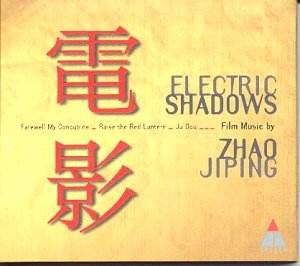
This unusual, and therefore invaluable album for the serious film music enthusiast, is an insight into Jipling's highly individual but very effective mix of Chinese/Western music for films from China like Raise the Red Lantern and Farewell My Concubine which have won great international acclaim and awards. It is a potent combination that has broad international appeal yet still retains the essential Chinese spirit and culture. Indeed, its impression of authenticity is enhanced with the inclusion of so many colourful Chinese instruments - - sometimes en masse as in the use of the percussion instruments of the Beijing Opera for the aforementioned scores.
In short, this is a collection of entrancing music beautifully played and recorded in vivid sound.
Zhao Jipling's work has embraced opera and orchestral and chamber works as well as film music. His non film music includes: Silk Road Rhapsody, a concerto for wind instruments and orchestra; the Yellow River Suite; the symphonic poem, The Baltic; and the opera The Elm Blossom. Zhao Jiping was the only representative of an Asian country to be invited to take part in the Second International Discussion Forum on Film Music in Switzerland. He has been the subject of a documentary film shown throughout the world.
An explanation of the album's title - "Electric Shadows" is a term borrowed from the popular art form of the shadow-show and is the literal translation of the Chinese word for film.
The opening two tracks are of music from the film To Live and a number of ethnic instruments are featured over slow moving strings to produce dream-like ethereal music of serene beauty. These instruments are: the banhu (a Chinese string instrument) the erh-hu (a two-string bowed fiddle, and p'i-p'a (a lute that is played vertically).
The Sunbird tells of the fate and struggle for survival of a female dancer in a claustrophobic Chinese society and uses a large orchestra with a sheng (a seventeen-pipe mouth organ) and bawu (a bamboo flute) adding to the iridescent range of colour. Two numbers are included from the score, `Two Trees' and `Spirit of the Peacock' After a quiet meditative opening for sheng and organ-like synths, wooden blocks and assorted drums accompany Yang Liping in her speech-song, in march/dance like rhythms and in crescendo and increasingly faster tempi. `Spirit of the Peacock' is a lovely evocation: one imagines woodwinds in birdsong, harp figures portraying little cascades of water and small bells summoning spirits. At length the music quickens and to a frenzied dance complete with an array of tambourines, drums, blocks and gongs before it broadens out into the sort of grand romantic theme one would associate with the Hollywood's Golden Age.
Ju Dou was a melodrama about an older, impotent man who mistreats his young wife and loses her to his adopted nephew. Zhao uses practically only a single instrument a xun, an oviform wind instrument made from clay (with gong strokes and timpani rolls and other percussive instruments for colour and dramatic effect plus a child's voice intoning a traditional song). The xun wonderfully expresses both sexual longing and at the same time denial as well as a kind of otherworldly wistfulness.
Farewell My Concubine charts 30 years of chaotic social upheaval in China's history as seen through the eyes of two actors from the Beijing Opera. It begins with the massed percussion of the Beijing opera sounding, to western ears, perhaps, more like the clashing of pan lids than cymbals and like music that might be associated with the dragon parades in celebration of the Chinese New Year. The two cues are entitled: `Brotherly Love and Stage Life' and `The Curtain Falls'. Contemplative music, at first accompanied by a wheezy sounding wind instrument, then develops into pastoral/mystical material that strongly reminds one of Vaughan Williams in similar mode. Later in `The Curtain Falls' more assertive and dramatic music alternates with softer material played on another mix of exotic instruments.
Red Firecracker, Green Firecracker is about sexual transgression and moral transgression. The two-movement suite begins with gentle, then increasingly passionate love music for slow moving strings and ethnic winds, with horns adding a forlorn note and distant perspectives in `The Love between Chun Zhi and Niu Bao' `On the Yellow River:Unflinching Love' introduces more western-style sweepingly dramatic music, although I would not go so far as to equate it with Steiner or Korngold as the author of the notes does, besides there is much exotica to underline dramatic turbulence.
The most significant part of this album is the 21-minute suite of music from Raise the Reed Lantern divided into four movements: `Overture', `Women (Xu Lian and Mei Shan)', `Fate' and `Metempsychosis'. In Raise the Red Lantern there are two dominant themes: the power of ritual over the freedom of the individual and the sexual and social repression of women in a feudal country such as China, still following the teachings of Confucius. Here Zhao Jiping uses a highly effective device borrowed from the Beijing opera with the chorus constantly repeating the phrase "Li-Ge Long" to express its utter contempt of women. The eerily threatening character of the music - a threat perceptible only on a subliminal level- serves to underscore the sombre events in the lives of the head of the household and his four concubines.
The chorus of womens voices, detached and beautifully ethereal even when intoning the dreaded `Li-Ge Long' (as if to repudiate the assertion), contrast with earthier percussion strokes to elevate `Overture' into an almost prayer-like elegy. This mood continues with the women's voices caressing `Women (Xu Lian and Mei Shan)' accompanied by glistening, sympathetic string figures. `Fate' knocks with cold insistent wooden block blows and more agitated womens' voices. This music has a sort of folk-song quality. The final movement, Metempsychosis, has a feeling of resignation, and chill distance, and detachment, but the force of `Li-Ge Long' is tempered with a cautious gentle optimism for the future?
A rewarding album for the adventurous film and film music enthusiast.
Reviewer
Ian Lace

THE FILM MUSIC OF ALAN RAWSTHORNE.
BBC Philharmonic/Rumon Gamba.
CHANDOS. CHAN 9749

Save around 22% with
the retailers listed at the bottom
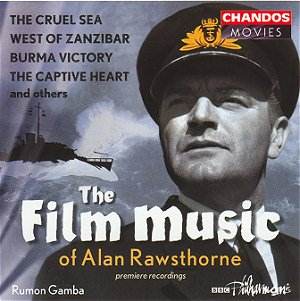
This representative selection of film music by Alan Rawsthorne ranges from war epics such as The Cruel Sea and Burma Victory to melodramas such as Uncle Silas and Saraband for Dead Lovers. However, arguably the most memorable tracks on the CD do not come from such powerful statements: the haunting waltz from Uncle Silas is a delight with its Prokofiev-like shifts of key and the graceful and charming Three Dances from "The Dancing Fleece" presage (and indeed outshine) the composer's 1955 ballet Madame Chrysanthème.
The Cruel Sea (Main titles and Nocturne) receives a brisk and forthright performance but compared to the version by the Royal Ballet Sinfonia conducted by Kenneth Alwyn on Silva Screen Records Ltd (FILM CD 177) the Chandos reading is a little stiff and plain. The Alwyn version takes more time over the score, especially the Nocturne and lavishes the music with a little more emotional commitment. By digging deeper into the music, the Silva Screen release makes the listener appreciate Rawsthorne's melodic and dramatic gifts even further.
The main title of Lease of Life is a moving miniature encapsulating and rising above the film's somewhat maudlin tale of a poor, ailing priest (played by the ailing Robert Donat) trying to get money to allow his fledgling pianist daughter to go to music college (hence the brief burst of piano music in the sequence). The bustling, energetic "VE Day" from The Captive Heart and the "Carnival" music from Sarabande for Dead Lovers are clearly from the same pen as the "Street Corner" Overture. I find these upbeat episodes more entertaining and more revealing of Rawsthorne as a composer and personality than the slightly impersonal "stiff upper lip" war film music (though the Cruel Sea track contains a vivid and stark seascape). Nonetheless, all the pieces assembled here provide a very valuable addition to the Rawsthorne discography, complementing his more "serious" orchestral works such as the three symphonies and the concertos and it must be said that in some cases it is the film music which boasts the more memorable invention!
One minor quibble - the otherwise informative and well-illustrated accompanying booklet fails to mention the dates of the films included on this CD. They are discussed in chronological order in the programme notes but here are the dates of the films in the order in which they appear on the disc: The Captive Heart (1946); West of Zanzibar (1953); The Cruel Sea (1952); Where no Vultures Fly (1951); Uncle Silas (1947); Lease of Life (1954); The Dancing Fleece (1950); Burma Victory (1945) and Sarabande for Dead Lovers (1948).
The playing of the BBC Philharmonic under Rumon Gamba is exemplary and the Chandos recording is as clear and full-bodied as we have come to expect from this source. I hope this release will turn out to be the first part of a series of CDs devoted to the film music of Alan Rawsthorne. There are many more fine scores yet to be released on disc, including: Broken Dykes (1945); The Drawings of Leonardo da Vinci (1953); Floods of Fear (1958); The Legend of the Good Beasts (1956); The Man Who Never Was (1956); Messenger of the Mountains (1964); Pandora and the Flying Dutchman (1951) - a surprising omission from the Chandos CD; Port of London (1959); School for Secrets (1946); Street Fighting (1942) and Waters of Time (1951). On the strength of the quality of the material on display in this Chandos disc, Rumon Gamba and his BBC forces should lose no time in mining further treasure from the Rawsthorne film scores. Recommended to film music fans and admirers of Alan Rawsthorne alike.
Reviewer
Paul Conway
SONY SK 89239 [35:10]

Save around 22% with
the retailers listed at the bottom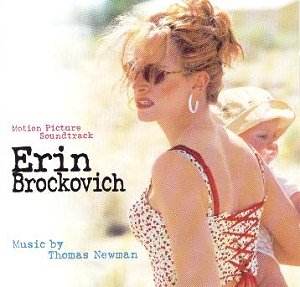
For Erin Brokovich, Newman appears to be in a hangover situation from American Beauty. Once more we have what on the surface seems to be a flimsy score with material based on simple musical figures endlessly repeated modulating through related keys and decorated with a variety of instrumental and synth colourings - as I said its American Beauty revisited and expanded. There is a feeling of musical meandering, music off the cuff, extemporisation (there is much jazz orientation); in fact, two or three tracks like `Pro Bono' have music that might have been composed by an Aeolian harp swayed by random breezes - pleasant meanderings.
This score has sufficient variety to sustain interest - just about. The opening track `Useless' blends synths with piano in a nicely laid back easy listening style. A number of tracks follow this pattern, one of the best of which is `Two Feet Wrong' that has piano with a syncopated mix of synths. Elsewhere, as might be expected, the music takes a more eerie and sinister turn in response to the unfolding drama. One track `Malign' even has Indian inflections mixed in its ascending eerieness. Strings and piano float softer, dreamy material seamed with poignancy for tracks like `Miss Witchita' and `Anabelle'.
'A pleasant, undemanding musical experience; but certainly not one of Thomas Newman's better scores. He seems to be treading water here.
Reviewer
Ian Lace

But Jeffrey Wheeler is even less enthusiastic:-
Thomas Newman currently holds the title of one of the most creative voices in the world of film music. (Note to the readers: Please do not ask me if a large gold belt or oversized trophy comes with that title. I honestly have no idea.) In trusting his thought and skill one suspects he would agree, if grudgingly, that not every innovation is a good one. His score for the fact-based law film "Erin Brockovich" is the sort of garrulous, dramatically lackluster electronic amble his father proscribed tooth and nail. I can only hope this is an isolated incident; Mr. Newman does better with orchestral soundscapes and atmospheric sounds than with gadgets and gizmos.
The Erin Brockovich theme is a snappy piece clearly styled by Newman. It is spicy and up-tempo... and wholly undermined by the so-called urban sound. It remains recognizable throughout, at least. Barely. Other themes steadfastly avoid memory cells. I am not exactly sure there are other themes. The parts muddle Newman's typical orchestral style into a circuit board, an all-electric scattering of acoustic ideas to form a mildly engaging wall of white noise. Samplers, drum machines, and electronic keyboards rarely form the ideal emotional arsenal, especially not when soft-core jazz provides the lone source of interest. As entertaining as it may sound, something other than variety must certainly act as the instigator. The delineation between tracks begins to blur after track five... or is track six?
The production for this disc is not much at about 26 minutes of original underscore. Two of Sheryl Crow's hit songs, 'Redemption Day' and the halfway decent 'Every Day is a Winding Road,' serve to verify the precise abrasiveness of Crow's mishandled voice and illustrate the historical insignificance of the Billboard charts. My attention wanders to the album insert, where the highlight of the release has little to do with the music: There are several motion picture stills of Julia Roberts in skimpy outfits. One of those outfits is leather. It's better than a Victoria's Secret catalogue... so I hear, of course... Now, why would I lie about something like that?
Reviewer
Jeffrey Wheeler

OST
VARÈSE SARABANDE VSD-6120 [41:20]

Save around 22% with
the retailers listed at the bottom
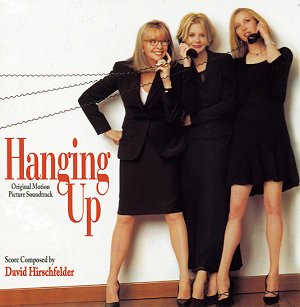
Comedic scores are often difficult to get enthusiastic about, as there just isn't the same scope for a composer as when working on genres such as fantasy and adventure. But even allowing for this, I found David Hirschfelder's work here rather bland and uninspiring.
The central theme, heard in various incarnations throughout the score, is introduced in `It's Too Late' and is slightly surprisingly with its dissonant chord structure. There is also plenty of variety in the instrumentation and even if there is some overly familiar string work in the mid-section, I was reasonably optimistic after this solid start. Sadly though, from here on nothing much else occurs to elicit any positive response. Many tracks like `Eve and Maddy are Hondas', `Eve and Ogmed' and `Thanksgiving' offer sentimental piano and strings that I expect will serve adequately in the film, but really leave a lot to be desired in terms of musical invention. The real problem is that we've been here so many times before. It's all rather forgettable and I really can't imagine wanting to come back to this in the future. Film music by the numbers would be an apt description and it's not a good sign when the best tracks are the obligatory songs. In this case there are four, `Georgia on my Mind' sung by Steve Tyrell and All-4-One, `Once Upon a Time' performed by Jay McShann, Dean Martin's appealing version of `Let it Snow! Let it Snow! Let it Snow! and the truly wonderful `Have Yourself a Merry Little Christmas' with vocals by Judy Garland. This heart-warming classic (featured in the enchanting 1944 production Meet me in St. Louis) is almost worth picking up the album for alone. Unfortunately there is little else to recommend it.
Reviewer
Mark Hockley

London Metropolitan Orchestra, Mark Isham
Trumpet MILAN 73138 35906 [41:59]

Save around 22% with
the retailers listed at the bottom

There is a moment within the first track ('No Victories, No Defeats') where the brass section and military percussion rise above the somewhat cliché solo trumpet, sounding unusually like a glorious throwback to the Silver Age of motion picture music. I thought, If the score holds onto this momentum then here is one of the most interesting score of 2000 thus far.
Mark Isham's "Rules of Engagement" does not maintain a steady motion, but it possesses enough dramatic strength and musical distinction to provide average entertainment. It observes many of the expectations for a military courtroom/conspiracy melodrama -- there are the aforementioned trumpet solos and the obligatory snares and those overly modest 'tension' cues that deliberately aim to annoy by leading nowhere (One of the rules of disengagement?). The groundwork of the score comes from an earlier Isham composition, 'On the Threshold of Liberty,' that is not only acknowledged and credited but also included in its entirety at the end of the disc for comparison! Hurrah!
The nicely performed trumpet solos by Isham are more introspective than usual. "Rules" has an air of somber reflection. The obligatory frazzled strings and sustained chords dominate the atmospheric cues, along with synthesized ruckus that divert attention from the orchestral backing...The reoccurring 'heartbeat' is a transparent horror device that wangles the listener into feeling assaulted, and it works. I wish the blasted thing would just go away.
So the score does not grow far beyond its roots, and more substantive writing could certainly make a greater emotional impression notwithstanding, Isham does achieve a captivating tautness when every note is said and done. Three tracks of material not contained in the film, including the aforementioned original recording of 'On the Threshold of Liberty,' flesh out the disc. The packaging offers the standard assortment of motion picture stills plus notes from the director. As an album it is of the sort one reserves for an impulse buy - a purchase that brings satisfaction, but is not necessarily worth every bit of thoughtful effort.
Reviewer
Jeffrey Wheeler

************************************************************** EDITOR'S RECOMMENDATION **************************************************************
OST
VARÈSE SARABANDE VSD-6114 [56:51]

Save around 22% with
the retailers listed at the bottom
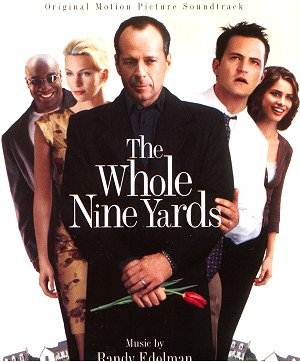
1. Jimmy the tulip
2. I don't worry about a thing.
3. A new neighbour
4. Moanin'.
5. Did you say divorce?
6.Tenth avenue tango.
7. The gogolak mansion.
8. Every time I hear that mellow saxophone.
9. Cynthia with a "C".
10. Autumn leaves.
11. Yanni on a string
12. Frankie figs.
13. The gang arrives in Montreal.
14. A swingin' barbecue.
15. Oz gets a surprise.
16. Say I do.
17. I think we'll be fine.
18. Phone tag.
19. Frantic.
20. Sensuous Lady.
21. Scheming on a boat.
22. Taking a stand.
23. Discovering the evidence.
24. The games' afoot.
25. Sophie cons Jimmy.
26. The scientific method.
27. The tulip reprise.
28. They all laughed.Musical Director and Composer Randy Edelman has done an excellent job here, I found this to be one of the most enjoyable film scores I have listened to. Some of the music pre-dates the film by some years; however the score loses nothing by that and each of them is a gem.
Track 4 Moanin' comes from a Charles Mingus Big Band album "Blues and Roots", first released in April 1987 and recently used on TV in a Tetley's Bitter Advert. As a reminder it's the one where the wet dog clears a path across a crowded beach in order that a guy who throws a stick, can get to the bar. It is interesting that the work of Mingus, which was regarded as "avant garde" in the 70's & 80's was mainstream by the turn of the century. Mingus who was a very creative bass player and composer, arranger and bandleader died in 1979, but he left a legacy of music that changed the face of jazz composition.
Another great contribution is track 2, " I don't worry about a thing", where the late Mose Allison, a bluesy singer, song-writer and pianist, who had a unique style demonstrates his talent to the full. This track comes from an album called "Lessons for Living" released on Electra in 1984.
The Up Top Orchestra is new to me, but " Every time I hear a mellow saxophone" is a very musical performance by a top class band. The Charlie Biddle Trio and vocalist Stephanie Biddle are also new to me, but they are very impressive. Stephanie has that great since of time that only the best of jazz singers ever possess and the trio is the kind of jazz backing group every front line soloist or singer would like to work with (including me!). It was nice to hear "They all laughed again", for anyone who needs a reminder of the quality of song writing George and Ira Gershwin were capable of, here is a the proof.
The Bruce Willis " Tenth Avenue Tango" track features some excellent blues guitar and will appeal to jazz and blues fans equally.
Randy's score for the film is a fine piece of work, beautifully performed by a group of top quality studio musicians, when you listen you can hear how each section was tailor made to fit a particular situation in the plot, this is the work of someone who is on the top of his profession.
To reiterate this is the most enjoyable album of film music I have heard in along time.
Reviewer
Don Mather

Don Mather is a saxophone player and Bandleader in Coventry UK.
Wojciech KILAR La Neuvième Porte (The Ninth Gate)OST Sumi Jo (Soprano); The City of Prague Philharmonic and Chorus conducted by Stepan Konicek
SILVA SCREEN FILMCD 321 [54:07]

Save around 22% with
the retailers listed at the bottom
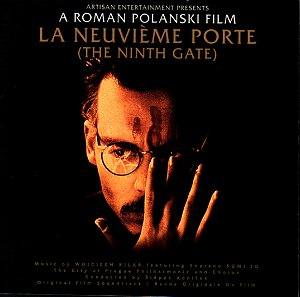
Wojeiek Kilar has created, without having to resort to synth bolsterings, a sort of modern Gothic score that must be chillingly effective in the theatre. It is certainly darkly scary in its own right.
The first cue 'Vocalise' - the main theme lets us into the horrors gently with slow faltering piano and harpsichord figures supporting a sweetly melancholy soprano intoning wordlessly. The title is indicative for this track is very reminsicent of Rachmaninov's work of the same name. Clever this because Rachmaninov's music was often doom-laden and frequently based on the Dies irae chant for the dead. This cue becomes more intense as first upper strings joining the texture followed by lower stings adding gravitas. The Opening Titles are an exercise in deepest, blackest string writing suggesting a malignant stalking menace. Higher strings add staccato stabbings augmenting the sense of deep foreboding with no relief.
'Corso' is a strange jazzy contrast. Over syncopated harpsichord and pizzicato strings, an assertive, domineering solo trumpet holds centre stage. The music, at this point, sounds very much like Prokofiev or Shostakovich. Then lower woodwinds continue the jaunty syncopations grotesquely before doleful strings continue the slow malignant march of the Opening Titles. 'Bernie is dead' is another eerie/sinister/darkly comic cue for pizzicato double basses and bassoons with piano struck in its highest register, those syncopations return for a 'sick' funeral march. Liana moves the music to highest strings and treble percussion, piano, vibraphone, celeste, bells etc giving a remote, glistening other-worldly. The music is repetitive, almost hypnotic, minimalist Philip Glass-like subtly modulating and shifting dynamics. Another contrast presents itself as 'Plane to Spain' (Bolero) as the domineering trumpet now becomes really proud and haughty proclaiming over strong Spanish-rhythms in the strings. This part of the cue reminds one of both De Falla and Ravel but soon the rhythm slows and the mood darkens to a sense of foreboding once more. Those high pitched piano chords jar the nerves in The Motorbike before mysterious high sustained brass chords and bells with a sort of echoing soprano solo screw the tension tighter. The 'Missing Book' summons back the jazzy syncopated chords with harpsichord and trumpet making sardonic comment then 'Stalking Corso' has spaced pounding percussion, heavy piano chords and snarling brass in frightening crescendo - the writing shows marked originality over the usual chase music.
The calm before the storm comes with the short soprano solo 'Blood on his Face.' 'Chateau Saint Martin' is an eerie exercise for high strings and percussion with muffled cymbals it sounds like the chiming of many clocks and finally mournful and finaly disonant tolling of bells. 'Liana's Death, 'Boo' and 'The Chase' are all creepy, Gothic, fearsome don't look behind you cues all masterly written. But it is 'Balkan's Death' that really impresses. Timpani and percussive poundings with repeated tam-tam strokes and low bassoon grumblings suggest the beast arising from the fires of hell. A devilish men's chorus (Orf-like) reinforces this feeling of utter evil and malice. Only the soprano voice promises any relief. 'The Ninth Gate' is another remote-sounding soprano solo followed by mysterious high register music seems to usher in music that has a redeeming radiance. 'Corso and the Girl' suggests victory of light over darkness - or does it?
Soprano Sumi Jo's beautifully pure tones add poignancy in contrast with the score's palpable malignancy; and the City of Prague Philharmonic is on top form. An extraordinary, darkly memorable score.
Reviewer
Ian Lace

Edel 0108742DNY

Save around 22% with
the retailers listed at the bottom
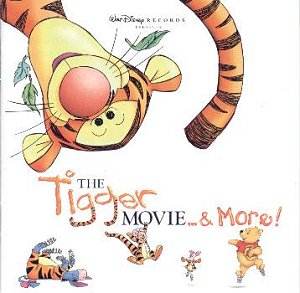
Ian Lace writes: this album comprises 14 charming songs, mostly jolly, tongue-twisting and high spirited, and some a little sad; the last two 'Forever and Ever' and 'Winnie the Pooh' (sung by Long John Baldry) bringing a nostalgic lump to this old throat - silly ole bear, that I am! They are all nicely conceived in the spirit of well-loved A.A. Milne stories. The CD ROM content with scenes form the film is amusing and appealing. The booklet has all the lyrics and plenty of pictures of Pooh, Tigger, Rabbit, Piglet, Kanga, Roo, Eeyore, Owl and of course Christopher Robin. I think all I need do is to list the songs below with brief quotations from their words and then leave things up to my expert eleven year old reviewer, Raya Verrecchia.The Wonderful Thing About Tiggers …is they're bouncy, trouncy…fun,fun,fun…
Someone Like Me… who laughs and sings and jumps everyday…
Whoop-de-Dooper Bounce … the more you try, the more you fly…
Pooh's Lullabee … Honey bees in the tree Your honey is safe tonight [aha?]…
Round My Family Tree… heroicus figgers of my ancestor tiggers…
How to Be a Tigger… paint black stripes on our underwear and glue on whiskers too…
Your Heart Will Lead You Home … just think of your friends, the ones who care…
(Your Friendship Is) The Best Present Ever …better than a plane, a train, ice cream…
Wherever You Are … I'll hear your laugh, I'll see your smile…
It's Tough Being Small … Piglet..you're very small [but] You've got a very big heart
Nobody wants To Be My Friend … except for Winnie the Pooh, Piglet, Owl, Tigger…
Everything is Right …Perfectly, wonderfully, totally…Right now! Silly old bear
Forever and Ever …I want you right here beside me forever
Winnie the Pooh … tubby little cubby all stuffed with fluff - silly ole bear.Raya Verrecchia says:
I thought all the songs were good. Two of them were very good: 'Forever and Ever' which was nice and cute, lovely words and very nicely sung; and 'Your Heart Will Lead You Home' is nice and soft, beautifully sung; and you could fit a picture in your mind to go along with the music. 'Pooh's Lullabee' was nice too, mainly for little children, I think it would easily put them to sleep.
The whole album is ideal for children from 4 to 9 years of age. Winnie the Pooh and Tigger have always been favourites of mine; and these songs and the ROM part of the CD which introduced all the characters, make you want to see the film.
BUT I did not like, one bit, the man who sings "Winnie the Pooh"!!
Songs: **** Music ***(*) Whole CD ***(*) ROM ****
Reviewer
Raya Verrecchia
ANGEL 7243 5 24905 2 3 [65:11]

Save around 22% with
the retailers listed at the bottom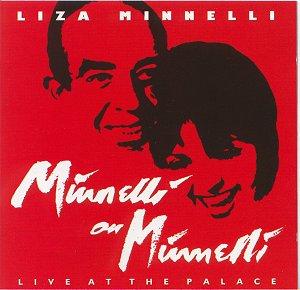
This is the live recording of the opening night performance, last December, at the Palace Theatre on Broadway, of Minnelli on Minnelli - Liza's highly emotional tribute to her father Vincent Minnelli (1903-1986) who directed all those spectacular MGM musicals. Liza returns, in triumph, after all her struggles against addictions and surgeries. The Palace was where Liza's mother Judy Garland, made her celebrated comebacks in 1951 and 1967. What pain and suffering those two women endured.
The emotion clearly got to Liza in the opening phases of the show. There is a hesitancy and strain in the voice, it sounds a bit woolly (too close-miked?) and with an uncharacteristically awful Overture from Marvin Hamlisch, and much too prolonged audience applause, I was set to write off this album as an embarrassing indulgence. But soon Liza's confidence picks up and she sings with all the old zest and panache and the album keeps getting better and better until at the end you want to leap up and cheer along with the audience. In the closing stages of her show, she has the wit and courage to send herself up in a clever parody of `I'm Glad I'm Not Young Any More'(from Gigi) in which she expresses her lack of concern for her age (she's 54) her weight and "a seven foot drag queen dressed like me". She then follows this up with a moving tribute in words and music to her parents singing `The Trolley Song' from Meet Me in St Louis (the first time she had sung this song made so famous by her mother) and concluding with a new song written for her in tribute to her father, `I Thank You.'
The whole show is built around the music from the films of Vincent Minnelli. There are medleys from Meet Me in St. Louis (1944), and The Band Wagon (1953), with numbers from Cabin in the Sky (1943) The Clock (1945) Ziegfield Follies (1946), An American in Paris (1951), Kismet (1955); and On A Clear Day You Can See Forever (1970). Highlights include: Liza singing `The Boy Next Door' and `Have Yourself A Merry Little Christmas' that so movingly bring back memories of her mother (how alike their styles are!), Liza's superb and joyful rendition of `Shine on Your Shoes' (The BandWagon) easily equalling Fred's joie de vivre; and her radiant `What Did I Have That I Don't Have?' (On A Clear day You Can See Forever) in which she outclasses Barbra.
A 20-page booklet includes a sympathetic article about the show by Rex Reed, a very useful `Vincent Minnelli Directorial Filmography' and many pictures of Liza with her father, some on the sets of his films and a few including Judy.
An album full of nostalgic charm and one that would simply be churlish to even begin to rate.
Reviewer
Ian Lace
Collection: Music for Stanley Kubrick's Clockwork OrangeWARNER BROS. 7599-27256-2 [46:23]

Save around 22% with
the retailers listed at the bottom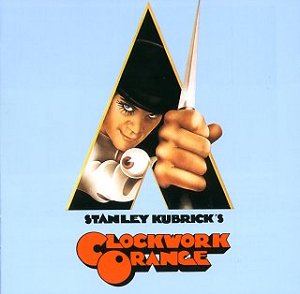
Music, in some cases electronically adapted and/or abridged from orchestral recordings, from Purcell (funeral music for Queen Mary), Rossini (The Thieving Magpie and William Tell overtures), Beethoven (Symphony No.9), Elgar (Pomp and Circumstance Marches No.1 & IV). Also including Overture to the Sun by Terry Tucker. Electronic music by Walter Carlos and Rachel Elkind. Songs: I Want to Marry a Lighthouse Keeper written and performed by Erika Eigen, Singin' in the Rain, composed by Freed and Brown, performed by Gene Kelly.
Now those of us under 44 finally have a chance to see A Clockwork Orange (non-UK readers may be amazed to learn that the film has been unavailable, at its director's insistence, in its country of original for over a quarter of a century). Those older than that can see it again. We can finally see what all the fuss was about, and more importantly for our purposes here, attempt to make some sense of the soundtrack album. I should note that the album reviewed here is the 15 track OST, not to be confused with the 10 track album, on the cover of which a very threatening knife is replaced with a glass of milk (threatening by implication only), but which includes the complete 13 minute version of 'Timesteps', here cut to 4 minutes. (You might wish it had been cut further - techno probably begins here).
The film is a flawed masterpiece, and one of the flaws concerns the use of music, specifically classical music. After the brilliant use of classical music in his previous foray into science-fiction, 2001: A Space Odyssey (1968), Stanley Kubrick decided to cover large parts of each of his following five films with classical extracts, almost entirely at the expense of any original score. No composer is credited on the cover, and you have to look inside the booklet to find the name Walter Carlos - later the Wendy Carlos who would score Kubrick's The Shinning (1980), and the proto-Matrix SF of Tron (1982). Carlos was a composer of electronic music who played a large part in the development of the Moog synthesiser, and achieved enormous commercial success in the late 60's with the album Switched on Bach. Though largely forgotten today, this was an incredibly popular LP, the first electronic music to find mainstream acceptance, the forerunner of the 70's synth/prog rock of Tangerine Dream and Jean Michel-Jarre, and ultimately, of the hellish clockwork cacophony which today passes for popular music.
But why do I think the use of music is one of the flaws of A Clockwork Orange?
(This is no place for a detailed synopsis: suffice to say that the film is near future SF, that in a dystopian Britain a teenage gang run on a riot of drug-fuelled sex and 'ultra-violence' until their leader, Alex, is imprisoned for murder and brainwashed into conformity.) The Alex of Anthony Burgess' source novel loved the music of Beethoven, and this love is kept in the film as the one signifier of Alex's buried humanity: Burgess himself wrote symphonies as well as novels, though recordings are hard to come by. The film features a mixture of straight extracts from Beethoven and other classical composers, plus electronic versions of other classical themes created and performed by Walter Carlos. Presumably the intent is to create a futuristic ambience, but nothing dates more quickly than last year's future, except perhaps electronic music. Somehow, combined with the very 70's look of the film, the music has dated A Clockwork Orange while 2001: A Space Odyssey remains astonishing impervious to the hand of time.
Anthony Burgess has explained the rather baffling title, which itself could have been the perfect name for a 70's rock band (think of Deep Purple, Pink Floyd, Tangerine Dream) as symbolising something sweet, good and life-giving, which has become bitter, lifeless and mechanical. Thus we might accept the electronic-classical soundtrack as a realisation of this idea, and to some extent it does work. The film opens with an electronic setting of part of Purcell's music for the funeral of Queen Mary - listed as 'Title Music from A Clockwork Orange' on the cover, and this is indeed portentously chilling in it's synthesised grandeur. It sets the scene well, and makes a strong opener to the disc.
However, the flaw I refer to runs much deeper: the synthesised versions of Beethoven make no sense in terms of the purpose of the film. In a key sequence in which Alex is brainwashed into feeling sick at the thought of violence or sex, the film footage used to condition him is accompanied by Beethoven's Symphony No. 9. The whole point of the brainwashing is to make Alex feel as bad as possible, yet Beethoven's Ninth is generally considered to be one of the most uplifting works in the classical canon. Thus its use in this context simply makes no sense, playing as crassly pragmatic plotting, engendering sympathy for Alex because afterwards he can no longer bear to listen to his favourite music: his one connection with higher human values, taken from him and corrupted.
Later, a writer by the name of Mr Alexander, having discovered Alex is responsible for his disabling injuries and, indirectly, for the death of his wife, tortures Alex with a recording of Beethoven's 9th. With wild implausibility Mr Alexander plays Alex the same electronic version of Beethoven which accompanied the mind-control film. Surely he would have a recording of the original? No one in their right mind would buy the electronic version featured here for pleasure, and surely it is far to improbable a coincidence for the cultured writer to chose to use this version over the real thing? Thus, on a level of pure plot, key musical ideas in the film simply do not work. Translated to CD, the disc is a bizarre mixture of orchestral extracts and electronic reworkings which makes for a uniquely alienating experience. If the idea is to put one off listening to Beethoven, then it works!
Rounding the disc off, Gene Kelly's incomparably wonderful performance of 'Singin' in the Rain' seems even more incongruous than does Alex's own shocking use of the song in the film itself. This is sweetness turned sour indeed, and I for one would sooner associate the song with it's 50's context rather than it's 70's corruption. Listening to the album is a surreal experience, from the mock vaudeville of 'I Want to Marry a Lighthouse Keeper', via Rossini and Elgar, the strange electronic soundscape of 'Timesteps', mutant Beethoven and innocent Kelly, it is as diverse, iconoclastic and uncomfortable as the film itself. The sound quality is also inevitably variable, with the orchestral recordings sounding better than the electronic ones. Is it any good? is a question which seems terrible old-fashioned and irrelevant here, but it is a useful document of an important film.
Reviewer
Gary. S. Dalkin
- as a coherent and enjoyable musical experience
- as a document of the film
Collection: Monstrous Movie Music: The Mole People; Them!; It Came From Outer Space; It Came from Beneath the SeaRadio Symphony Orchestra of Cracow conducted by Masatoshi Mitsumoto
[e-mail:monstrous@earthlink.net (www.mmmrecordings.com)]
MMM-1950 [68:38]
Collection: More Monstrous Movie Music: The Beast from 20,000 Fathoms; Tarantula; Gorgo; The Monolith Monsters
Radio Symphony Orchestra of Cracow conducted by Masatoshi Mitsumoto

[e-mail: monstrous@earthlink.net (www.mmmrecordings.com]MMM 1951 [59:03]

Save around 22% with
the retailers listed at the bottom
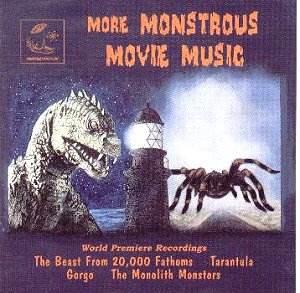
Ian Lace offers introductory remarks and his rating:-
In Hollywood's Golden Age, the major studios had their own music department and thankfully, directors and producers did not dictate or sway the style of the film music of that period. The good taste and sense of the heads of music departments carried real weight. It is a great pity that we cannot return to that system. I raise this point because these two albums reminded me that the studios had their own policy regarding music and the music of these studios, particularly Warner Bros., had their own quite unmistakable special sound. Warner Bros had a significant music department headed by Leo Forbstein who was responsible for hiring first rate talent such as Korngold, Steiner, Waxman and Tiomkin. Warner Bros. valued music highly and, significantly, they gave their major composers sole screen credits like their leading players and directors. For their major productions, the scores were practically all original.
On the other hand, Universal (or Universal International as it was known through the period of the films featured on these albums) valued music much less, more often than not allowing only a small credit in their technicians `page' listing and usually just: "Music supervised by Joseph Gershensen" or similar. Gershensen was not a composer but he was a very able administrator. Universal's budget-conscious policy was to use existing material over and over again, when suitable, so that many of their scores were really scissors and paste jobs. The wonder is that so much good work came from this albeit expert gluing process peppered with some sharp and adept original material. Amongst the composers working at Universal at this time was Henry Mancini whose work went uncredited.
It is quite noticeable, and not surprising therefore, that the best scores in these albums are from Warner Bros (and M-G-M) productions.
These two albums are quite remarkable. Having seen most of these films in their theatrical releases when I was in my teens I was bowled over by the accuracy of the sound world that had been created - particularly that recognisable Universal International sound I remembered hearing in the 1950s. But this is but one facet of the extreme care which David Schecter and Kathleen Mayne have lavished on these productions. Besides many film poster illustrations, the texts of the sumptuous booklets are crammed with carefully and meticulously researched detail - one gets the impression that no stone has been left unturned. (One also speculates that they have unearthed even more material that cannot easily be revealed, certainly they suggest that valuable material is being hoarded illicitly in selfish private collections.) Kathleen Mayne has done a remarkable reconstruction job and they have been fortunate in finding a pliant conductor and orchestra. They have an engaging attitude to this music viewing it with great affection and humour but also appreciating its limitations.
I leave Gary to give a detailed review of these albums and I look to further volumes in the series. But I hope that David and Kathleen will expend their undoubted talents in resurrecting more worthwhile scores from Hollywood's Golden Age. There is still plenty of scope. I recommend them to research all the Academy Award nominations as listed in Robert Osborne's marvellous book, 70 Years of the Oscar for starters.
Reviewer
Ian Lace

Gary S. Dalkin writes the main review
Ian Lace has already covered the sound and presentation of these albums, but I have to just mention that these discs offer a fantastic recreation of the 50's B picture ambience, while the booklets written by David Schecter are the result of astonishing dedication. Beautifully printed, incredibly detailed, phenomenally knowledgeable, and written with real wit this is the work of people who really love film music. Schecter, and Kathleen Mayne - who even suffered a spider invasion nightmare in the course of duty - really should be given some sort of special award for services to film music far and beyond the realms of duty. Monstrous Movie Music even features 5 short bonus tracks, music from It Came From Outer Space (1953) already featured, but now with the theremin parts removed and with instructions as to what noises to make for your own Karaoke versions. Resistence really is useless, and much less fun than going "Ooooo - wooooo - wooooo"
Now that might suggest that this is all a bit flippant. Nothing could be further from the truth, though it does indicate a health sense of humour and an acknowledgement that this was functional music that shouldn't be elevated too highly. Schecter and Mayne genuinely love 1950's B picture monster and SF movies, though they are not so blind in love that they can not see the flaws in these movies as well as the virtues so often overlooked by the mainstream. And if the films have gone generally unrecognised, so much more so the music. Now while it would be a mistake to lump all these films together as being much of a similar quality - like any other genre there is an enormous difference between the best and the worst - one can safely make the generalisation that none of these pictures where scored by the big name composers of the day. Whether an iconic classic such as Them! (1954) or the negligible The Mole People (1956) names such as Rózsa, Herrmann and Steiner were conspicuously absent from the soundstage.
The films were usually made quickly and cheaply, but often with much rough-hewn invention, and the same applied to the music scores. Writing this music was just part of the daily job to such almost completely unknown (even to film music fans) composers as David Buttolph and Irving Gertz. Yet if the names are unfamiliar, the music will be instantly recognised. Not, probably for individual pieces, or even for the work of any one of the composers, but for the overall sound: in the best possible way, the music on these albums is generic. Which is to say, so powerfully evocative is this music that it defines forever and always a particular time and place in cinema. Hear this music are you simply know you are in the world of black and white monsters, probably busy menacing Manhattan. As such, if you have any nostalgic love for these films at all, and if you grew up in the 50's, or in the 70's watching them over and over again on TV surely you must have, then you will find these discs an absolute treat.
There are quirks. Each disc essentially features three lengthy suites from classic or semi-classic SF movies made between 1953-61, so that it seems a little odd to have much shorter extracts from one much lesser film on each disc - The Mole People on the first album, The Monolith Monsters (1957) on the second. Still, more music from these is promised on a later volume, and soon we are going to be able to enjoy further releases featuring The Creature From the Black Lagoon (1954), Mighty Joe Young (1949) and This Island Earth (1955).
After Monstrous Movie Music opens with The Mole People, things really get going with Them! This tale of radioactive giant ants, which culminates in a terrific battle in the Los Angeles storm drains, was a major Warner Brothers production and was the studio's most successful film of 1954. The score was by Bronislau Kaper, now remembered most for his work in the 1962 version of Mutiny on the Bounty. The disc offers 27 minutes from the score, and it is simply great stuff, developing the sound of film noir as established by Miklós Rózsa in the 40's in such hard-bitten crime/thriller scores as Brute Force and The Naked City to new levels of atmospheric monstrousness. Here is the template for many of the insect rampages which would follow throughout the 50's, and let us not forget that without Them! there would be no Aliens (1986) and no Starship Troopers (1998). The bug-hunt starts here.
It Came from Outer Space (1953) was part of the 3-D boom of the early 50's, a terrific little SF thriller (and not a monster movie at all) directed with great economy by the king of 50's SF film world, Jack Arnold. A script by Ray Bradbury ensured that this was superior fare. The music, a collaboration between Herman Stein, Irving Gertz and Henry Mancini (a decade before entering the big league with The Pink Panther) delivers considerable brooding suspense and archetypal menace. There's even a hint of Rite of Spring in 'Visitors from Space', though Stravinsky never used a theremin! The Beast From 20, 000 Fathoms dates from the same year, and is nominally based on the Ray Bradbury story The Foghorn. The film is a true monster flick in the tradition of King Kong (1933), getting the jump on Godzilla (1954) by a year, and by making $5 million on a $200 000 investment probably inspiring Warner's Them! in the first place. The dinosaur-on-the-loose film is notable today for being the great stop-motion animator Ray Harryhausen's first feature, and thus a half-way stage between King Kong and Jurassic Park. To say that David Buttolph's does exactly what is expected of it, lending real quality to what is a really rather ponderous and technically limited film, is high praise. The suite from Mischa Bakaleinkoff's score for It Came From Beneath the Sea (1955) is comparatively short at 9 minutes, but offers all the giant-octopus-wrestling-with-the-Golden-Gate-bridge action most people will probably ever need.
Tarantula (1955) was Universal Studios entry into the rampaging giant insect stakes, and not only features a very young Clint Eastwood, but again offers the talents of Stein and Mancini, this time without Gertz. Once more this is terse and explosive music, leaving just Gorgo (1961), a film from the tale-end of the monster boom years scored by Angelo Francesco Lavagnino. This was a rare British attempt to make a monster movie - as opposed to a Hammer horror movie - and provides the rare chance to see Big Ben get the sort of punishment usually reserved for American landmarks. The score suffered considerably in the release version of the film, but 19 minutes are restored here for all to enjoy, including the surprisingly romantic and rousing finale music. How fitting that for once, as the cycle of monster movies drew to an end, the beasts should have a happy ending.
It has to be said that the music between the scores from these various films is really rather similar. However, there are gems throughout both discs and I wouldn't be without either and am eagerly looking forward to further releases. It might be that to really appreciate these albums you have to have that special love for these wonderful old films that some people simply have, and other's just don't get. But even so, anyone who loves film music should really have at least the first of these discs in their collection, while for true monster movie fans both these albums packed full of world premiere recordings are simply essential.
Reviewer
Gary S. Dalkin
(both albums)
DIMITRI TIOMKIN Feature
Following on from our Tiomkin feature last month (Now preserved in our articles section) we include, this month, reviews of five key albums of Dimitri Tiomkin's film music.
************************************************************** EDITOR'S RECOMMENDATION **************************************************************
Dimitri TIOMKIN Lost Horizon. The Guns of Navarone. The Big Sky. The Fourposter. Friendly Persuasion. Search for Paradise.Charles Gerhardt conducting the Ntaional Philharmonic Orchestra.
RCA Victor GD81669

Save around 22% with
the retailers listed at the bottom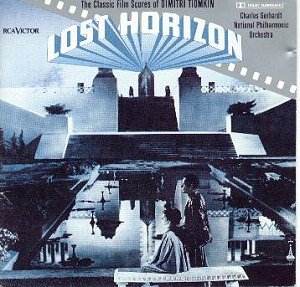
This 1976 recording was later reissued on CD
This is one of the best of RCA's 1970s Classic Film Scores series with Charles Gerhardt conducting the National Philharmonic Orchestra, the members of which were specially selected from amongst the finest players of London's orchestras. The series was engineered by Kenneth Wilkinson and recorded in the marvellous acoustic of London's Kingsway Hall. Dimitri Tiomkin, himself, was in attendance, and took an active interest in the recording sessions for this album.
The major item is the 23-minute suite from the 1937 Frank Capra classic for Columbia, Lost Horizon, from James Hilton's celebrated novel about an idyllic civilisation, a paradise, hidden in a remote Tibetan valley. It was Tiomkin's first major film score. Hollywood. Max Steiner, on loan to Columbia, conducted the score for the film.
The suite opens in great epic sweep with a Prologue that includes a few bars of the love theme and that wonderful, extraordinary music representing Shangri-La which has an affinity with Oriental or medieval monody to give a timeless but infinitely serene quality. But then the music erupts into turbulence for `Riot in Baskul' and the `Mob Scene at the Refuelling Station'. Wild exotic choral and orchestral music recalls Borodin, in PrinceIgor mode, as the hijacked plane lands in the middle of nowhere to be refuelled by a swarm of bearded and turbaned tribesman.
After the plane crashes on the vast Tibetan plateau, Chang's caravan escorts the plane's passenger's over storm-swept mountain country to dour, nasal woodwinds. The music marches slowly and wearily working to a huge crescendo that suddenly evaporates. Only distant chiming bells and voices are heard as the travellers come in sight of the Celestial City, "a cloistered Eden where people live to unheard-of ages". The following tracks are concerned with the peace and serenity of life in the beautiful surroundings Shangri-La. A lovely nocturne, that embraces the love theme, is followed by evocative sequences: the (horse) `Riding Sequence', `The Waterfall' and `Chinese Children's Scherzo'.
But the high point of the score is reached with the `Bell Sequence' and `Funeral Cortege of the High Lama'. The long winding Shangri-La theme is projected against a kaleidoscopically changing background of harmony and orchestral-choral colour. The huge percussion section (reasembling the Javanese gamelan or percussion orchestra) includes: xylophone, vibraphone, marimba, five glockenspiels, three sets of tubular bells, two sets of the very large Parsifal chimes, a set of tuned cymbals, four tuned Tibetan gongs, three tamtams of different sizes and a Tibetan instrument known as the rata drum.
The brief 2½-minute Prelude to The Guns of Navarone is worth the price of this album alone. This performance, of one of the most thrilling pieces of music ever penned by Tiomkin, has all the bite and attack that is missing from the rival Citadel (formerly on Unicorn-Kanchana) recording also reviewed this month.
Beginning and ending quietly The Big Sky is an unusual western score. Howard Hawkes's 1952 film (Tiomkin also scored Hawkes Red River and Rio Bravo), was set along the Missouri River, in the 1830s, a somewhat earlier period than the majority of western adventures. It concerned the lives of the early settlers, trappers and Indians. Tiomkin's music is often idyllic, a vivid sound painting of the beautiful wooded and mountainous countryside. The `Indian' figures are treated with the utmost sympathy and subtlety. `Forest at Night' is "an atmospheric nocturne with cloudy, impressionistic textures and solo trumpet and horn each merging momentarily from the gloom-coloured shadows; the rhythmic mutter of tom-toms is heard and the night grows into a love theme" -- one of Tiomkin's most haunting love themes.
People who have contributed to our debate on Tiomkin have remarked about the difficulty of Tiomkin's scores. The sparkling, quicksilver high-spirited Overture to TheFourposter is a perfect example. This little piece may sound carefree but its cross-rhythms, rapidly fluctuating tempi and extraordinary instrumental demands such as high violin harmonics are a great challenge to both orchestra and conductor. This track, the whole album indeed the whole RCA Classic Film Score series is a tribute to the remarkable, skills and dedication of Charles Gerhardt.
The 1956 film, Friendly Persuasion was set in an Indiana Quaker community at the time of the Civil War. Starring Gary Cooper and Dorothy McGuire, it was, for the most part, an idyllic western. The big hit from the film was the title song (aka `Thee I Love'). Jess (Cooper), in his love of music, has purchased an organ, scandalising his wife Eliza (McGuire) who rushes off in a huff to the barn where Jess follows her. Magically, in this celebrated scene, Tiomkin holds back only allowing fragments of his beautiful melody to float as Jess quietly coaxes Eliza round, the music cleverly pointing their conversation with many changes of mood. At length the big romantic theme is allowed through as domestic harmony is re-established.
The album alas ends in something of a downbeat with the, in my opinion, bordering-on-the-banal, Choral Finale for the Cinerama production, Search for Paradise.
Notwithstanding the short final item, this is a compulsory purchase for Tiomkin fans
Reviewer
Ian Lace

Dimitri TIOMKIN The Guns of Navarone. The Fall of the Roman Empire. A President's Country. Rhapsody of Steel. Wild is the WindThe Royal College of Music Orchestra conducted by Sir David Willcocks (David King - organ)
CITADEL STC77128 [56:56]

Save around 22% with
the retailers listed at the bottom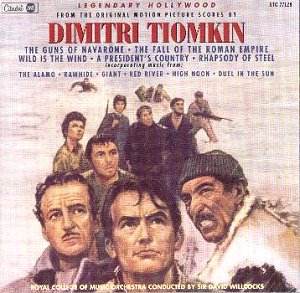
The first thing to realise is that this is a re-release of the 1985 Unicorn-Kanchana album - `The Film Music of Dimitri Tiomkin' DKP(CD) 9047. Despite the stunning sound and the doubtless enthusiasm of a student RCM orchestra, the essential Tiomkin idiom too often escapes them. How much this is due to the bizarre choice of conductor David Willcocks, more at home in Kings College Chapel, Cambridge or conducting choirs in Bach and Handel etc one cannot say. Like the curate's egg this album is good in parts. My hunch is that Christopher Palmer who arranged and orchestrated Rhapsody of Steel persuaded Unicorn-Kanchana to record this album (and the `Western Film Music of Dimitri Tiomkin' much better performed by Laurie Johnson and The London Studio Symphony Orchestra) when he was producing the wonderful series of Delius recordings with Eric Fenby? Possibly it was thought that the RCM orchestra would provide an economic solution and Willcocks may well have viewed the project as good publicity and good exercise for the RCM students?
The positive side first. The inclusion of the music for the documentary, Rhapsody of Steel is a real bonus. This score has all the hallmarks of Tiomkin's dynamic music, with an abundance of excitement, and wit and glitter, and vivid evocation. The film and score cover the history of the development of steel stretching from the Iron Age through the discovery of steel in India and its appropriation by the sword-makers of Damascus to the birth of the steel age in the 19th century with all its consequent dramatic power. The second part of the composition follows the multifarious uses of steel in a busy urban community. The music is a playful set of variations on `I Feel Wonderful'. As Palmer says, "a big jazzy chrominum-plated climax builds in which all the sights and sounds of the metropolis seem to converge (taxi horns among them). Its eupeptic spirit is similar to that of the rowdier parts of An American inParis - `A Russian in New York'? The concluding fugato has a heroic lyricism as we look outwards to the use of steel in space exploration.
A President's Country was a score for another documentary score designed to show off the south west of Texas, homeland of President Johnson. The score was a compendium of themes and songs from Tiomkin's great western scores: Red River, Duel in the Sun, Giant, Rawhide, High Noon, and The Alamo. The RCM deliver a vibrant reading with their tongue firmly in their cheeks and they really relish the wayward arrangement of the Rawhide theme.
Christopher Palmer's `Pop ballad' arrangement of Wild is the Wind (made famous as a single by Johnny Mathis) is a good example of Tiomkin's romantic lyricism -- at best, probably, in Friendly Persuasion. This performance is rather heavy-handed.
The 10½-minute suite from The Guns of Navarone begins well with the evocative Prologue underscoring views of the Greek islands and James Robertson Justice's narration. But when the tempo picks up after initial martial strains, and the famous big theme emerges the tempo suddenly drops back again too much and the excitement sags. Listen to Charles Gerhardt on the rival RCA recording to hear how exciting this music can really sound.
The same applies to the Overture of The Fall of the Roman Empire. The urgency and grandeur that is heard on the soundtrack is missing. Granted the sound is impressive but much more bite is necessary. `Pax Romana' the splendid ceremonial music underscoring the extended scene in which tribute is made to Emperor Marcus Aurelius (Alec Guiness) from representatives of his far-flung empire fares better.
An album of highs and lows, but one that should be in every Tiomkin-lover's collection.
Reviewer
Ian Lace

Dimitri TIOMKIN The Western Film Music of Dimitri TiomkinLaurie Johnson conducting the London Studio Symphony Orchestra and John McCarthy Singers
Unicorn-Kanchana UKCD2011 (46:15)

Save around 22% with
the retailers listed at the bottom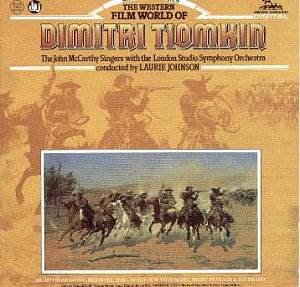
This is an earnest effort at recording, and thus preserving, a handful of works by Tiomkin who was for many years Hollywood's foremost Western film composer. The excerpts included are, in some cases judicious and valuable (High Noon, Night Passage, Red River) and in others somewhat questionable (Duel in the Sun, Giant) as I will explain later.
My personal favorite among these is Red River, represented here by five cues, each well (if simply) conceived by Tiomkin and quite well realized here by Laurie Johnson and something called the London Studio Symphony Orchestra along with the John McCarthy Singers. The score opens with a powerful horn statement, raising the curtain on director Howard Hawks' massive saga of a Texas cattle drive. The main title is based primarily on a simple tune `Settle Down' (credited in the film to Tiomkin with no mention of a lyricist) which has the comfortable feel of a standard cowboy ditty. Tiomkin uses this theme effectively but somewhat sparingly throughout the movie, relying more heavily on the cattle theme, a robust melody for horns and brass that accompanies the `Red River Crossing' cue and numerous other scenes involving the giant herd of Texas steers. The music implies both muscle and motion, and marks a more mature Western voice than previously displayed by Tiomkin.
The Red River portion concludes with `The Challenge,' in which Tiomkin's trademark strident chords become a march-like rhythm matching what, for me, is a signature scene in Western films: John Wayne striding relentlessly through the herd of meandering steers, intent on a deadly showdown with Montgomery Clift.
Speaking of showdowns, none is more famous in Western film lore than the one Gary Cooper awaits in High Noon. For this film, Tiomkin broke all the conventions: his main titles open quietly, a single strummed guitar, followed by a ballad that continues throughout the film, telling the story in a laconic, fateful voice (supplied by Tex Ritter in the film, baritone Bob Saker here. There are several versions of how High Noon was elevated from a grade-B oater to a classic drama. In one, director Fred Zinnemann dropped the project as soon as filming was completed, and editor Elmo Williams stepped in to restructure the film in actual time, thus creating the tension that made it a hit. Tiomkin's ballad-based score completed the package. The second version is told by Tiomkin: The film was previewed in a suburb east of Los Angeles to disastrous results, leading the studio to yank it from release. But then Tiomkin released the ballad as a single (with Frankie Lane replacing Ritter, because a different recording company was involved) and the song became an immediate hit, thus resurrecting the film's commercial viability.
Whatever the case, High Noon remains a remarkable achievement today in no small part due to its score, the highlights of which are the cues `The Clock' and `Showdown.' In the first, Tiomkin's strings throb to the swinging of the clock pendulum as it nears high noon, while against this ostinato is played one element of the ballad theme, that which previously carried the lyric "Oh, to be torn `twixt love and duty."
For `Showdown,' Tiomkin displays this entire theme in various full and partial forms, bending it every which way to complement the dramatic action. This is film scoring of the first order and it justifiably received the Academy Award in 1952 (one of only three Oscar nominations Tiomkin received for his Western scores). Johnson's handling also is first-rate -- no small achievement as noted elsewhere in my review of Tiomkin's Fall of the Roman Empire.
I also liked the main-title version of `Follow the River,' the song Tiomkin and High-Noon lyricist Ned Washington wrote for Night Passage in 1957. The theme is soft and flowing and well-performed by the John McCarthy Singers.
I'm much less interested in Duel in the Sun, although this 1945 David O. Selznick production is a landmark for Tiomkin if only because it's his first Western score. (Officially, The Westerner in 1940 was his first, but Alfred Newman reportedly was brought in to rewrite most of that music.) And there is at least one great story told of a confrontation between Tiomkin and the ever-meddling Selznick who, the story goes, interrupted a scoring session to complain about Tiomkin's love theme. "That's not how I make love," Selznick declared. "Look, Selznick," screamed the exasperated Tiomkin, `this is how I make love!"
Author Tony Thomas has noted that Selznick listed four specific emotions he wanted in the score: jealousy, flirtation, sentiment and orgiastic. To Tiomkin's credit, much of this can be heard in the `Love-Death' cue contained on this recording, which follows the `Trek to the Sun,' an impressionistic bit of writing that utilizes a wordless male chorus to help depict the arid desert. The score then literally rages through a gamut of emotion, as the lovers (Gregory Peck and Jennifer Jones) shoot each other and then die in each other's arms. No wonder Duel in the Sun was dubbed by critics "Lust in the Dust."
My reservations about the inclusion of Giant in this recording stem not from the score or this particular performance of the `Prelude,' both of which are fine -- it's vigorous, broad-shouldered music that speaks directly to what Texas is: big, broad and powerful. But why include music from a score that's readily available already (particularly on LP, as Giant was back in 1981, when this recording initially was made.) The real value of this recording is that it offers music not recorded elsewhere. Rather than Giant, why not The Sundowners, Last Train from Gun Hill, or even The War Wagon, Tiomkin's final Western score?
"The Western Film World of Dimitri Tiomkin" concludes with three cues from Rio Bravo, a 1959 re-teaming of Hawks and Wayne which has attained cult status for the well-developed relationships of its many characters. (Incidentally, both Hawks and Wayne intended the film as an answer to High Noon, which both detested, but that's another story.) Tiomkin's music is pleasantly laconic as befits the story, and the cue `De Guella' is interesting in part because he used it just a year later, albeit more dramatically, to open The Alamo. It's used largely as source music, as I recall, in Rio Bravo, although Johnson's setting with guitars is nicely done.
Overall, I'm quite impressed with what Johnson has achieved here. This isn't the best re-recording of Tiomkin's works available - that distinction rests with Elmer Bernstein, whose FilmMusic Collection recordings of Land of the Pharoahs and Gunfight at O.K. Corral and The High and Mighty are unsurpassed. Charles Gerhardt's recording for the
RCA Classic series is nearly as good. But Johnson has captured much of the feel, the tempo and the rhythm that make Tiomkin so unique.
Reviewer
John Huether

Ian Lace is more enthusiastic:-
In general, I share John Huether's opinion about this album but I must declare my admiration for it. It is certainly one of the jewels of my entire record collection. I have lost count of the number of times I have played it, captivated by the sheer exuberance of the Red River music; the drama and bite of this High Noon; and the warm sentimentality of `Follow the River' from Night Passage. Then there is the stunning trumpet and guitar and marimba playing of the De Guella from Rio Bravo. I cannot agree with John about Tiomkin's music for Duel in the Sun. I always remember the wonderful thrilling music that underscores the very imposing gathering of Lionel Barrymore's vast following in response to his summons to challenge of the encroaching railroad. This is one of the most spectacular scenes in western `filmography' and Tiomkin responds triumphantly. There is a hint of this music in this suite's Prelude.
Yes, I'm prejudiced. I just have to give this marvellous album
Reviewer
Ian Lace

Rundfunk Symphony Orchestra, Berlin, Rundfunk Choir Berlin conducted by Lawrence Foster
RCA Red Seal 09026
62658 2
Save around 22% with
the retailers listed at the bottom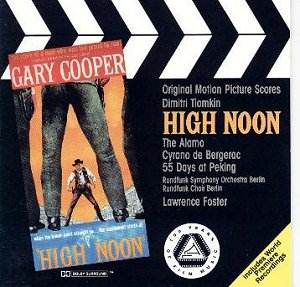
The most interesting score here is Cyrano de Bergerac. This was the 1950 United Artists production starring José Ferrer as the big-nosed poet-duelist hero. The four movement suite opens with a splendid Overture that not only has heroic sweep and grandeur and a lively spirit but also 17th century grace. `Roxane' (wittily subtitled 17th century blues) combines romance for the heroine, and hilarious figures (oboe and bassoon mostly) for the cavorting of Cyrano and the handsome but shy and bumbling Christian de Neuvilette. He is desperately in love with Roxane but needs the help of the far more articulate Cyrano to help him romance her. More sinister music comes in `Street Fight' at first of quiet malignant stealth then of open combat, the latter anticipating the main theme of guns of Navarone. `Requiem' is deeply affecting with its sweet violin solo beneath quiet women's voices. Later the music grows to a glorious climax commemorating Cyrano's glorious exploits.
High Noon in Christopher Palmer's arrangement here is a grittier, starker statement than that of Laurie Johnson on the rival Unicorn Kanchana recording. The pace, the rhythms are urgent and compelling. The sound stage is thrillingly exploited but for my taste this version is a tad too bleak.
The most substantial work in this compilation is the 27-minute The Alamo Suite. This gutsy performance has plenty going for it and is a strong rival to the original soundtrack recording reviewed on this site last month. Davy Crockett's music is jaunty and ripely ribald; the battle music across wide and deep perspectives has plenty of attack and is very thrilling with the De Guella lusty and defiant. `The Green Leaves of Summer' and `Tennessee Babe' presented as two intermezzos are both warmly sentimental and in the case of the former beautifully romantic and in the latter elegiac - almost hymn-like. In both cases the Rundfunk Choir sing most sympathetically and their English diction is excellent.
The 1963 Samuel Bronston spectacular, 55 Days at Peking was a rather stodgy epic weighed down by too many romantic interludes. This, for me, was not one of Tiomkin's Best scores. Despite some nice oriental touches, he seems to be treading water using far too many of his trademark phrases as almost make-weight. It is interesting to note that one of the most satisfying cues is the charming `Intermezzo:Children's Corner' that segues into an evocative oriental decoration that is the main love theme. The Overture has no memorable theme it is a mish-mash of urgent running figures and fragments of material one recalls from earlier scores such as Strangers on a Train, all spiced with quasi-oriental percussive figures. The romantic theme introduced in the overture is OK but again not one of Tiomkin's best and it certainly overstays its welcome becoming almost mawkish as when it overlays the source martial music of `Welcome Marines'.
`Attack and explosion' has its moments -- stealth and bombast; I particularly liked Tiomkin's use of bell, and piano in forward percussive mode. The best tracks in this uneven score are those that are most Chinese in inflection, especially the jubilant `Chinese Victory Celebration' and the trudging but jubilant `Hauling the Gun' with exotic percussion and ringing voices that often contrastingly highly pitched.
For Tiomkin fans another confident recommendation.
Reviewer
Ian Lace

OST
Sony-PEG Recordings 029 (38:53)

Save around 22% with
the retailers listed at the bottom
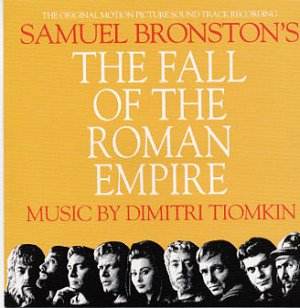
The best way to see The Fall of the Roman Empire, the acerbic critic John Simon once noted, was with a musician friend who owed you money. "After 10 minutes of Dimitri Tiomkin's music," Simon said, "he'll be limp; after three hours you can remove his wallet."
Well, perhaps. To say this is a vigorous score would be understatement. Likewise, to say it's an epic work and a classic of the now long-dead Hollywood spectacular genre also would be understatement. In his liner notes to the original LP soundtrack in 1964, Tiomkin tells of being asked if he was considering "a gimmick score" (very much in vogue at that time) to represent 2nd century Rome. But no, the then 70-year-old composer makes it clear from the opening notes of the main title -- a powerful solo organ -- that he'll stick with a standard symphonic approach, thank you very much. Building on that organ solo, Tiomkin introduces his primary theme -- later titled `The Fall of Love' -- in strings and later woodwinds, varying its development only slightly as he exercises the full orchestra with powerful flourishes of brass. This theme will recur throughout Fall of the Roman Empire, occasionally in contrapuntal form as in the aptly titled cue `Tarantella," which accompanies the furious chariot duel between Stephen Boyd and Christopher Plummer. But it is two set pieces -- `Pax Romana' and `Roman Forum' -- that are the hallmarks of this score (and the music most likely to make that musician friend go limp).
The first, `Pax Romana,' underscores a lengthy scene in which a host of foreign leaders under Rome's authority are summoned to meet with the Roman leader, played by the incomparable Alec Guinness. As each passes by, he and Guinness exchange greetings. It would be interminable but for Tiomkin's glorious music - written as an ongoing fanfare in a processional mode, if you will. The cue lasts over five minutes. I'd be tempted to call it a tour de force, but that term is better applied to `Roman Forum,' which clocks in at just under five minutes and depicts the gamut of activity portrayed on what was, at least to that point, the largest set ever built for a motion picture.
Two other cues deserve particular mention. For `Ballomar's Barbarian Attack,' Tiomkin utilizes an expanded range of bass drums supported by smaller percussion, deftly outlining the attackers' crude weaponry and tactics. In marked contrast to this, as well as to the more vigorous cues already mentioned, is `Resurrection,' a sublimely lyrical, almost hymn-like piece of music for the death of James Mason who, along with Guinness and Plummer, nearly saves Fall of the Roman Empire from collapsing under its own weight.
While Tiomkin's score is broad in scope, his approach is perhaps a bit more conservative than, say, Newman's or Rozsa's in scoring historical epics. He even eschews a chorus- perhaps wisely, given that audience tastes were changing by the mid-60s, but surprising nevertheless, given how effectively he utilized choral accompaniment in his only other sword-and-sandal epic, Land of the Pharoahs..
It's also interesting to note that Tiomkin apparently used a pickup orchestra in London to record this score. The liner notes refer simply to "110 of England's finest musicians," even though he used the Sinfonia of London to record The Guns of Navarone a mere three years earlier. That Tiomkin was able to elicit such an incredible performance from musicians presumably not accustomed to playing together regularly is tribute to his conducting skills. And all the more reason why landmark scores such as this need to be heard in their original versions. As Screen Archives' Ray Faiola has noted, Tiomkin's music is awfully difficult to reproduce, due in part to his conflicting rhythms and his conductor's "penchant for fierce attack."
While it would be nice to have another 20 or 30 minutes of Fall of the Roman Empire in an expanded release, we can at least celebrate having these 39 minutes from the original LP available on CD.
Reviewer
John Huether


 |
| Discs
on these pages are offered for sale. There is also a page of search
engines from a selection of on-line retailers
here.
Please support this web-site by buying your discs here. Disclaimer: Every effort is made to make sales links to the correct disc but, in the end, you must take responsibility for checking that what you are purchasing is what you want. Some of these discs were not actually available for sale at the time of posting but a link has been made in anticipation of their forthcoming availablility. |
Return To Film Music on the Web
e-mail:
info@musicweb.uk.net